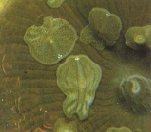 Question: How do you turn an aquarium brown, that was once full of colour?
Question: How do you turn an aquarium brown, that was once full of colour?
Answer: Introduce a few brown flatworms!
As unlikely as this may sound to those who have no experience of this menace, it is alarmingly true. Although flatworms of this species are only a few millimetres in length they can reproduce both sexually and asexually, meaning that it takes only one specimen to ultimately infect a whole tank. Given the right conditions, the flatworms go for all out reproduction and soon cover literally everything that does not move, including rocks, glass, equipment, algae, corals and sand. Within months the sheer weight of numbers smothers sessile livestock to the point of destruction! Not a pleasant thought but if left unchecked the end result is a brown, lifeless mess.
Brown flatworms arrive on living rock and corals, generally from tanks that are already infected. They are quite difficult to spot unless you are looking closely for them and have the ability to move into the safety of tiny cracks in the rocks at an unbelievable speed.
Interestingly brown flatworms not only feed on the micro organisms covering the surfaces that they appear on but they also have a symbiotic algae within their tissues providing sustenance, much like many corals and anemones; hence the reason why they thrive in brightly lit aquaria, occupying the most brilliant locations.
The Solution
Once again, fish-only aquaria can be treated with copper which will destroy these tiny invertebrates. Unfortunately, the reef aquarium cannot be dosed in the same way and suitable alternatives have to be found.
If the colonies are spotted at an early stage, then siphoning the area several times each day should clear the problem fairly quickly, but it takes a sharp eye and great deal of luck!
Some species of fish have been known to eat flatworms; these include Mandarins, Wrasses, Damsels, Butterflyfish and Tangs, BUT experience has shown that it is only individuals within these groups and NOT the groups as a whole. For every one damsel that will enjoy consuming flatworms, I could produce maybe one hundred that will not touch them under any circumstances! It is strongly suspected that a toxin within the skin makes them unpalatable to all but the most persistent of fish.
Specific chemical controls are unavailable for the reef aquarium, although some bacterial medications work very well. In my own trials, I have double-dosed with an aquarium bactericide called Myxazin twice each day (12 hours apart). After 10 days, all trace of the flatworms will have gone, although resting eggs might mean a re-infestation at a later date and the treatment will have to be repeated. During treatment the protein skimmer, activated carbon and UV steriliser need to be disconnected.
Tip: Although brown flatworms are small and fairly difficult to see, there is an easy way to spot them in a dealer's tank. Many of them like to gather on the front glass just below the strengthening bar, close to the light. This makes them very easy to locate, especially with a small magnifying glass.
© Nick Dakin. May not be reproduced in part, or whole, without permission.

